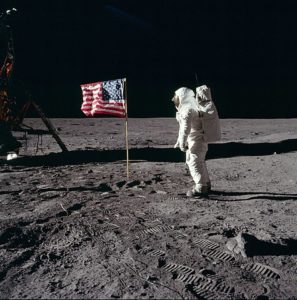Moon Landing Flags
They’re too far away for us to see, even with the most powerful telescopes, but they’re some of the most famous flags in history. NASA planted six flags on the moon, but the one that sticks in our memories is the flag that Buzz Aldrin and Neil Armstrong planted from Apollo 11 in 1969.
Many of us watched it on live TV. It was grainy and black and white, but we were still amazed. On July 20, 1969, about 11:40 pm (EDT), astronauts Neil Armstrong and Aldrin had some difficulty working the flagpole into the lunar soil. The makeup of the soil only allowed them to get it 6 inches deep.

Still, they did their best, and an American Flag was placed in the lunar soil. Aldrin stepped back to salute the flag, and Armstrong took the famous picture. It’s now an iconic piece of history and the type of photo that makes us dream of what else is possible.
As good as NASA engineering was on the lunar lander, the design of the flag wasn’t thoroughly thought out. The flag itself was a standard, $5.50 3 by 5-foot nylon flag ordered from a government supply catalog. The top was folded over and sewn around an aluminum crossbar that made the flag look like it was waving. The flagpole was aluminum tubing, and necessarily short to accommodate the astronaut’s limited motion in their spacesuits.
It was placed about 27 feet from the lunar lander. Unfortunately, The astronauts think that the blast of the rockets during take-off knocked it over. Astronomers that can see the site confirm that there’s no shadow, which would back up the idea that it fell over. It is also expected that the everyday nylon flag construction degraded quickly from heavy UV exposure.
Later Apollo missions included more robust flags and flagpoles and were planted further from the landing modules. The last Apollo flight carried the larger, 6-foot flag that had been hanging in the Mission Control Center.